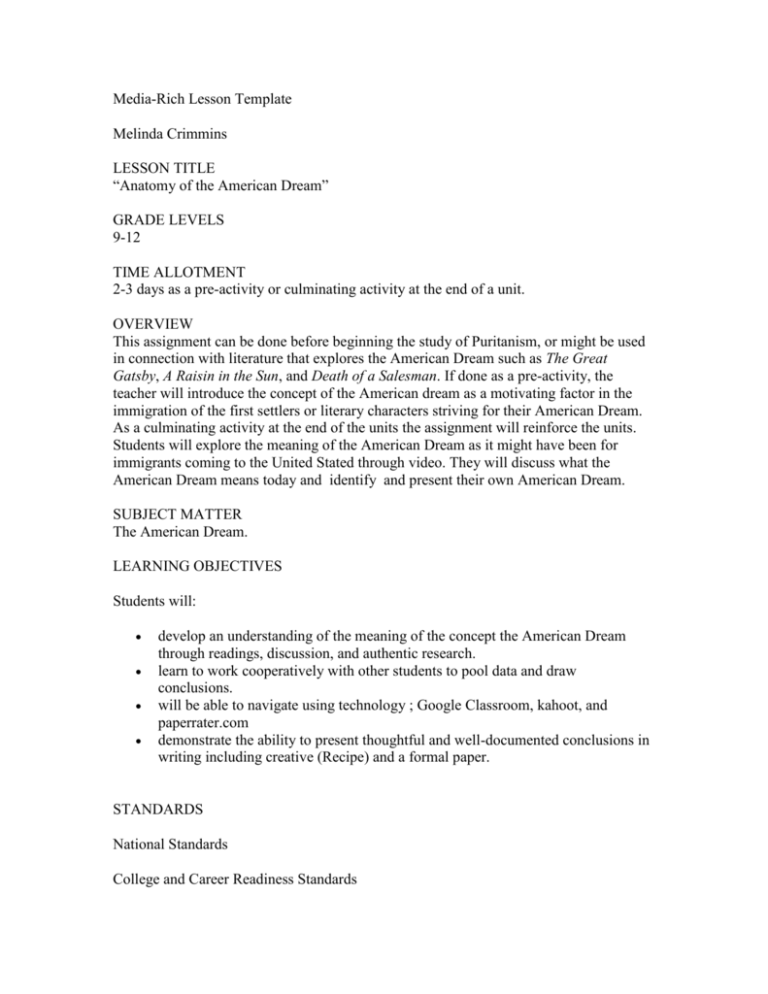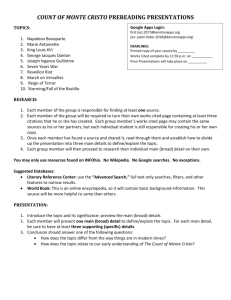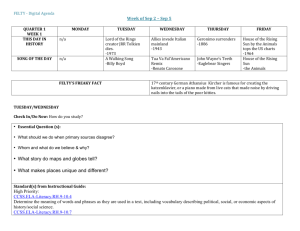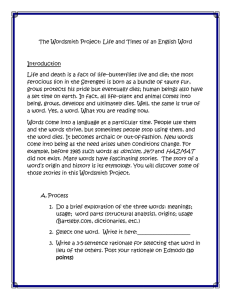Lesson Plan - Prairie Public
advertisement

Media-Rich Lesson Template Melinda Crimmins LESSON TITLE “Anatomy of the American Dream” GRADE LEVELS 9-12 TIME ALLOTMENT 2-3 days as a pre-activity or culminating activity at the end of a unit. OVERVIEW This assignment can be done before beginning the study of Puritanism, or might be used in connection with literature that explores the American Dream such as The Great Gatsby, A Raisin in the Sun, and Death of a Salesman. If done as a pre-activity, the teacher will introduce the concept of the American dream as a motivating factor in the immigration of the first settlers or literary characters striving for their American Dream. As a culminating activity at the end of the units the assignment will reinforce the units. Students will explore the meaning of the American Dream as it might have been for immigrants coming to the United Stated through video. They will discuss what the American Dream means today and identify and present their own American Dream. SUBJECT MATTER The American Dream. LEARNING OBJECTIVES Students will: develop an understanding of the meaning of the concept the American Dream through readings, discussion, and authentic research. learn to work cooperatively with other students to pool data and draw conclusions. will be able to navigate using technology ; Google Classroom, kahoot, and paperrater.com demonstrate the ability to present thoughtful and well-documented conclusions in writing including creative (Recipe) and a formal paper. STANDARDS National Standards College and Career Readiness Standards R.1.AE ( Level C (4â“5) ): Refer to details and examples in a text when explaining what the text says explicitly and when drawing inferences from the text. R.1.AE ( Level C (4â“5) ): Quote accurately from a text when explaining what the text says explicitly and when drawing inferences from the text. R.2.AE ( Level C (4â“5) ): Determine a theme of a story, drama, or poem from details in the text; summarize the text. R.2.AE ( Level E (9-12) ): Determine a theme or central idea of a text and analyze in detail its development over the course of the text, including how it emerges and is shaped and refined by specific details; provide an objective summary of the text. R.3.AE ( Level A (Kâ“1) ): Describe the connection between two individuals, events, ideas, or pieces of information in a text. R.3.AE ( Level E (9-12) ): Analyze a complex set of ideas or sequence of events and explain how specific individuals, ideas, or events interact and develop over the course of the text. R.6.AE ( Level B (2â“3) ): Identify the main purpose of a text, including what the author wants to answer, explain, or describe. Common Core State Standards CCSS.ELA-Literacy.RL.11-12.1 ( Grades 11-12 English Language Arts ): Cite strong and thorough textual evidence to support analysis of what the text says explicitly as well as inferences drawn from the text, including determining where the text leaves matters uncertain. CCSS.ELA-Literacy.RL.11-12.2 ( Grades 11-12 English Language Arts ): Determine two or more themes or central ideas of a text and analyze their development over the course of the text, including how they interact and build on one another to produce a complex account; provide an objective summary of the text. CCSS.ELA-Literacy.RL.11-12.3 ( Grades 11-12 English Language Arts ): Analyze the impact of the author’s choices regarding how to develop and relate elements of a story or drama (e.g., where a story is set, how the action is ordered, how the characters are introduced and developed). CCSS.ELA-Literacy.RL.11-12.9 ( Grades 11-12 English Language Arts ): Demonstrate knowledge of eighteenth-, nineteenth- and early-twentieth-century foundational works of American literature, including how two or more texts from the same period treat similar themes or topics. CCSS.ELA-Literacy.RL.9-10.1 ( Grades 9-10 English Language Arts ): Cite strong and thorough textual evidence to support analysis of what the text says explicitly as well as inferences drawn from the text. CCSS.ELA-Literacy.RL.9-10.2 ( Grades 9-10 English Language Arts ): Determine a theme or central idea of a text and analyze in detail its development over the course of the text, including how it emerges and is shaped and refined by specific details; provide an objective summary of the text. CCSS.ELA-Literacy.RL.9-10.3 ( Grades 9-10 English Language Arts ): Analyze how complex characters (e.g., those with multiple or conflicting motivations) develop over the course of a text, interact with other characters, and advance the plot or develop the theme. Common Core State Standards Common Core State Standards CCSS.ELA-Literacy.RL.11-12.10a ( Grades 11-12 English Language Arts ): By the end of grade 11, read and comprehend literature, including stories, dramas, and poems, in the grades 11-CCR text complexity band proficiently, with scaffolding as needed at the high end of the range. CCSS.ELA-Literacy.RL.11-12.10b ( Grades 11-12 English Language Arts ): By the end of grade 12, read and comprehend literature, including stories, dramas, and poems, at the high end of the grades 11–CCR text complexity band independently and proficiently. CCSS.ELA-Literacy.RL.11-12.2 ( Grades 11-12 English Language Arts ): Determine two or more themes or central ideas of a text and analyze their development over the course of the text, including how they interact and build on one another to produce a complex account; provide an objective summary of the text. CCSS.ELA-Literacy.RL.11-12.3 ( Grades 11-12 English Language Arts ): Analyze the impact of the author’s choices regarding how to develop and relate elements of a story or drama (e.g., where a story is set, how the action is ordered, how the characters are introduced and developed). CCSS.ELA-Literacy.RL.11-12.6 ( Grades 11-12 English Language Arts ): Analyze a case in which grasping point of view requires distinguishing what is directly stated in a text from what is really meant (e.g., satire, sarcasm, irony, or understatement). CCSS.ELA-Literacy.RL.11-12.9 ( Grades 11-12 English Language Arts ): Demonstrate knowledge of eighteenth-, nineteenth- and early-twentieth-century foundational works of American literature, including how two or more texts from the same period treat similar themes or topics. CCSS.ELA-Literacy.RL.9-10.10a ( Grades 9-10 English Language Arts ): By the end of grade 9, read and comprehend literature, including stories, dramas, and poems, in the grades 9–10 text complexity band proficiently, with scaffolding as needed at the high end of the range. CCSS.ELA-Literacy.RL.9-10.10b ( Grades 9-10 English Language Arts ): By the end of grade 10, read and comprehend literature, including stories, dramas, and poems, at the high end of the grades 9–10 text complexity band independently and proficiently. CCSS.ELA-Literacy.RL.9-10.2 ( Grades 9-10 English Language Arts ): Determine a theme or central idea of a text and analyze in detail its development over the course of the text, including how it emerges and is shaped and refined by specific details; provide an objective summary of the text. CCSS.ELA-Literacy.W.11-12.3b ( Grades 11-12 English Language Arts ): Use narrative techniques, such as dialogue, pacing, description, reflection, and multiple plot lines, to develop experiences, events, and/or characters. CCSS.ELA-Literacy.W.11-12.3c ( Grades 11-12 English Language Arts ): Use a variety of techniques to sequence events so that they build on one another to create a coherent whole and build toward a particular tone and outcome (e.g., a sense of mystery, suspense, growth, or resolution). CCSS.ELA-Literacy.W.11-12.3d ( Grades 11-12 English Language Arts ): Use precise words and phrases, telling details, and sensory language to convey a vivid picture of the experiences, events, setting, and/or characters. CCSS.ELA-Literacy.W.11-12.3e ( Grades 11-12 English Language Arts ): Provide a conclusion that follows from and reflects on what is experienced, observed, or resolved over the course of the narrative. CCSS.ELA-Literacy.W.11-12.4 ( Grades 11-12 English Language Arts ): Produce clear and coherent writing in which the development, organization, and style are appropriate to task, purpose, and audience. CCSS.ELA-Literacy.W.11-12.5 ( Grades 11-12 English Language Arts ): Develop and strengthen writing as needed by planning, revising, editing, rewriting, or trying a new approach, focusing on addressing what is most significant for a specific purpose and audience. CCSS.ELA-Literacy.W.9-10.3b ( Grades 9-10 English Language Arts ): Use narrative techniques, such as dialogue, pacing, description, reflection, and multiple plot lines, to develop experiences, events, and/or characters. CCSS.ELA-Literacy.W.9-10.3c ( Grades 9-10 English Language Arts ): Use a variety of techniques to sequence events so that they build on one another to create a coherent whole. CCSS.ELA-Literacy.W.9-10.3d ( Grades 9-10 English Language Arts ): Use precise words and phrases, telling details, and sensory language to convey a vivid picture of the experiences, events, setting, and/or characters. CCSS.ELA-Literacy.W.9-10.3e ( Grades 9-10 English Language Arts ): Provide a conclusion that follows from and reflects on what is experienced, observed, or resolved over the course of the narrative. CCSS.ELA-Literacy.W.9-10.4 ( Grades 9-10 English Language Arts ): Produce clear and coherent writing in which the development, organization, and style are appropriate to task, purpose, and audience. CCSS.ELA-Literacy.W.9-10.5 ( Grades 9-10 English Language Arts ): Develop and strengthen writing as needed by planning, revising, editing, rewriting, or trying a new approach, focusing on addressing what is most significant for a specific purpose and audience. CCSS.ELA-Literacy.W.9-10.6 ( Grades 9-10 English Language Arts ): Use technology, including the Internet, to produce, publish, and update individual or shared writing products, taking advantage of technology’s capacity to link to other information and to display information flexibly and dynamically. DIGITAL MEDIA COMPONENTS Google Classroom https://classroom.google.com paperrater.com www.paperrater.com Kahoot www.kahoot.it PBS Learning Media : American Dream Video http://tpt.pbslearningmedia.org/resource/aml15.ela.lit.amdream/what-is-the-americandream/ PBS Learning Media: Gatsby Guide http://www.neabigread.org/books/greatgatsby/teachers-guide/schedule-lesson-plans/ PBS Learning Media: Gatsby Video http://tpt.pbslearningmedia.org/resource/aml15.ela.lit.gatsamdream/gatsby-chases-theamerican-dream/ NY American Dream Interview http://www.eslvideo.com/esl_video_quiz_high_intermediate.php?id=13271 MATERIALS Internet connection Recipe of My American Dream pdf PREP FOR TEACHERS Using Google classroom set up a class and have students join. To create class, go to classroom.google. After the class is created, have students “join by typing in the code that is given for each class. Create the assignments in the class. Have students view and complete the assignments. If you prefer paper copies print the NY Interview questions handout, the Recipe of My American Dream, and the Essay assignment handout. INTRODUCTORY ACTIVITY: SETTING THE STAGE The American Dream is something we sing about, hear about, read about, and of course, dream about. The American Dream drew nearly 14 million immigrants to the U.S. in the past decades, but the American Dream means different things to different people. Students will study a variety of American Dreams throughout history then form their own definition of the American Dream and depict it in different medians. 1. Have students go to kahoot.it and type in pin code 461877 to take the What is the American Dream quiz. Students will be given four questions to answer and think about. The results from this quiz will be tallied and should be discussed as a whole-class activity. LEARNING ACTIVITIES 1. Have students take the Kahoot quiz and discuss the results. Ask students to discuss 2. 3. 4. 5. any knowledge they have of inaliable rights. Discuss what Life, Liberty, and the pursuit of happiness might have meant to immigrants coming to the U.S. and what it means to them. Distribute the NY Interview questions and have students view the video. You may want to stop the video and discuss each question as a class. Explain to students the topic of the next video and a larger theme of The Great Gatsby is the concept of the American Dream. These teaching tips all incorporate the notion of this American ideal. To provide context, explore the video What is the American Dream? Have students Answer the questions listed below the video. Have students complete one or all of the following culminating activitites. CULMINATING ACTIVITY Have students complete the My American Dream Recipe assignment and, or My American Dream essay assignment. Have students run their essay through the paperrater program receiving a grade of B or higher before turning in to the teacher. The following teaching tip is adapted from The Great Gatsby Teacher’s Guide from The Big Read, a program of The National Endowment for the Arts. After reading The Great Gatsby, analyze whether Fitzgerald was writing a love story that embraces American ideals, or a satire that criticizes them. To explore this topic, have students either write an argumentative essay or hold a class debate. For the essay, students should choose one side, and build their thesis and reasoning with evidence derived from passages in the book. For the debate, divide the class into two groups: one that will argue that Fitzgerald was writing a story that embraces American dream ideals and another that will argue that his goal was to criticize the American dream ideals. Have students conduct research, compile evidence, and prepare opening and closing statements and rebuttals. Students should refer to passages and quotes from the book as they build their arguments and use the Embracing or Criticizing the American Dream handout in the Student Handout tab to organize their evidence and statements. Dreaming of the Future Now that students have analyzed the American dream as it applies to the past era of The Great Gatsby, have them think about what the American dream of the future might entail. If their American dream is fulfilled, what will their lives look like when they are Nick’s age (approximately 30)? Consider different mediums for representing what their visions of their own future American dream will be: A monologue, from the perspective of their 30-year-old self A portrait of themselves as an adult who has realized the dream A letter to a loved (or not-so-loved) one describing their life A news article or report showcasing a major event CROSS-CURRICULAR EXTENSIONS Interview: Ask students to make a brief list of people they know who came of age in each particular decade (1950’s to the present). These should be people they would be able to interview, preferably in person though possibly in a phone conversation. Students may work in groups in order to cover all decades. Performance: Ask students to present their American Dream as a song or a acting out a scene from any piece of literature depicting the American Dream Music: Ask students to find and analyze lyrics depicting the American Dream. Play the song for the class and present their interpretation. An excellent selection of songs can be found on the Rock and Roll Hall of Fame website. History: Ask students to research an American individual “rags to riches” success story. Art: Ask students to create a poster (hard copy or digital) (Glogster.edu) and depict their American Dream. Extensions: Students could watch the animated film Fieval and write a compare and contrast paper with immigration presented in the film to the American immigration experience. If time and technology allows, students may be interested in viewing the powerful 1988 documentary American Dream at Groton which focuses on the challenges eighteen-yearold Jo Vega faces as a scholarship student at Groton Academy, a Massachusetts prep school. Vega was born in Spanish Harlem and struggles in her pursuit of the American Dream in a very different social milieu. Elementary: Ask students what makes them happy? Inform then that the words “American Dream” is usually associated with what makes people happy. Ask them to write down or illustrate three events that make them happy and ask them why they think those events make them happy. Have them write or draw what they hope their life will be like when they are their parents’ age. COMMUNITY CONNECTIONS Interview: Ask students to make a brief list of people they know who came of age in each particular decade (1950’s to the present). These should be people they would be able to interview, preferably in person though possibly in a phone conversation. Students may work in groups in order to cover all decades. STUDENT MATERIALS Preview the video for suitability for achieving the lesson’s objectives and students’ learning outcomes. Select Segments that are relevant to the lesson topic. Show the program in segments in order for the content to be more easily understood. Leave the Lights On It may reduce the sharpness of the picture – BUT – it gives the learners a message that Video Media is a PART of the lesson and the students will be responsible for the content in the video. Direct Students’ Focus to a specific task to complete during the video. Tell the students what they will see and what information from the video they should watch for. Identify the information during or after viewing the video. The teachers should introduce video segments with a question and review unfamiliar vocabulary. Introduce Activities before viewing the video to set the stage for learning. Teachers should provide background information and teach the new vocabulary words. Use Culminating Activities to help reinforce, apply, review or extend the information in the video clip. Pause the Video to check students’ comprehension. Ask questions, giving the students time to record information from the video. By pausing the video the teacher and students can examine a chart, a formula or an image on the screen more closely. Students could draw a diagram of what they have just seen on the video. Eliminate Sound or Picture The video clip may have unsuitable narration, but the video is outstanding. Turn down the sound and provide your own narration, or have the students describe what they see. Use the closed captioning with students reading along to reinforce vocabulary and improve reading comprehension. Why Use Video in the Classroom? Students: retain more information, understand concepts more rapidly are more enthusiastic about what they are learning make new connections between curriculum topics discover links between these topics and the world outside the classroom. Video is Uniquely Suited to . . . take students on impossible field trips--inside the human body, or off to Jupiter take students around the globe, to meet new people and hear their ideas illustrate complex, abstract concepts through animated, 3-D images show experiments that can't be done in class bring great literature, plays, music, or important scenes from history into the classroom Using the Power of Visual Images – Teachers . . . reach children with a variety of learning styles, especially visual learners and students with a variety of information acquisition styles engage students in problem-solving and investigative activities begin to dismantle social stereotypes help students practice media literacy and critical viewing skills provide a common experience for students.







